
Table of Contents
If you have a membership website, learning how to build a membership funnel is an important strategy to convert and retain new members.
Instead of relying on a single touchpoint to engage your visitors, your membership funnel lets you connect over multiple touchpoints to turn first-time visitors into long-term subscribers.
In this post, you’re going to learn everything that you need to know about how to build a member funnel for your membership site:
- What is a membership funnel? Including member funnels vs sales funnels
- Why using a membership funnel is important
- What you need to build a membership funnel
- How to set up a membership funnel for your site
Along the way, we’ll show you real examples of successful membership websites utilizing these types of member funnels.
What Is a Membership Funnel?
A membership funnel is a multi-step journey that takes a user from their first touchpoint with your site to becoming a paid member of your membership site.
In an ideal world, people would land on your site and sign up for your most expensive membership plan right away. But in the real world, it usually takes a little more time and effort to convert someone into a paying member.
Membership funnels address this by creating a multi-step journey to nurture customers and use multiple touchpoints to turn them into paying customers.
You also might see membership funnels called subscription sales funnels or subscription conversion funnels. Regardless of the name, the general idea is the same.
Membership Funnel vs Sales Funnel
You might already be familiar with the idea of a sales funnel, which is a multi-step journey that helps convert prospective visitors into paying customers.
A membership funnel shares a lot of similarities with a sales funnel, as the basic goal of both is to convert visitors into customers.
However, a membership funnel is specifically tailored to the unique needs of membership sites. For example, while a sales funnel is usually focused on a one-time sale, most membership sites will aim to turn people into long-term recurring members, which requires ongoing engagement to keep members from churning.
Similarly, your membership site might offer multiple membership levels/tiers. Part of your membership funnel might be focused on eventually moving users from the lower-level tiers to the higher-level tiers (which earns you more revenue).
Basically, unlike a sales funnel, a membership funnel isn’t finished after the initial membership purchase. It continues on and implements strategies to retain your members (to keep the recurring revenue flowing) and maybe even get them to upgrade to a higher-tier plan.
Why Is Using a Membership Funnel Important?
Using a membership funnel is important to help you maximize the chances of converting your website’s visitors into paying members.
Unless a person is already familiar with your brand and coming to your site specifically to sign up, they probably won’t be willing to join your membership community right away.
For example, let’s say a visitor found a post from your blog in a Google search or clicked on a link that was shared on social media.
These people are unlikely to join your membership community on their first visit. So if you just let them bounce away, you’ll miss out on the chance to turn them into members.
With a member funnel, you would start with a much lower “ask” – e.g. asking them to sign up to your email list. Then, over time, you would slowly work to convert them into becoming a member and then maintaining their membership over the long term.
What Do You Need to Build a Membership Funnel?
Now that you know what a membership funnel is and why it’s important, let’s get into some more actionable tips for how to build a membership funnel for your own website.
In this first section, we’ll discuss the general elements that you need to build a successful member funnel.
Then, in the next section, we’ll show you how to put those different elements together to build your own membership funnel strategy.
A Membership Website (Obviously!)
This first one is a bit obvious. But we just want to make it clear that you’ll likely want to already have your membership website in place before you start setting up your funnels.
If you haven’t built your membership website yet, you can use the open-source WordPress software and the Paid Member Subscriptions plugin.
Beyond offering all of the general features that you need to build a successful membership website, Paid Member Subscriptions also comes with some specific features that can help you build successful membership funnels:
- Unlimited hierarchical membership levels. You can link membership levels together in upgrade/downgrade paths, which lets you use your funnels to eventually move users to higher-tier plans.
- Free membership plans. In addition to multiple paid plan levels, you can also create free membership plans to act as a first step for visitors.
- Free trials to let users try a plan before making their purchases. You can also offer discount codes to entice users to upgrade.
- Content dripping to boost your customer retention by releasing content over time instead of all at once.
- Email marketing service integrations. When you combine Paid Member Subscriptions with the Profile Builder plugin (available via the Ultimate Membership Bundle), you can sync your members to email marketing services like Mailchimp and MailPoet to nurture your customers via email automation campaigns.
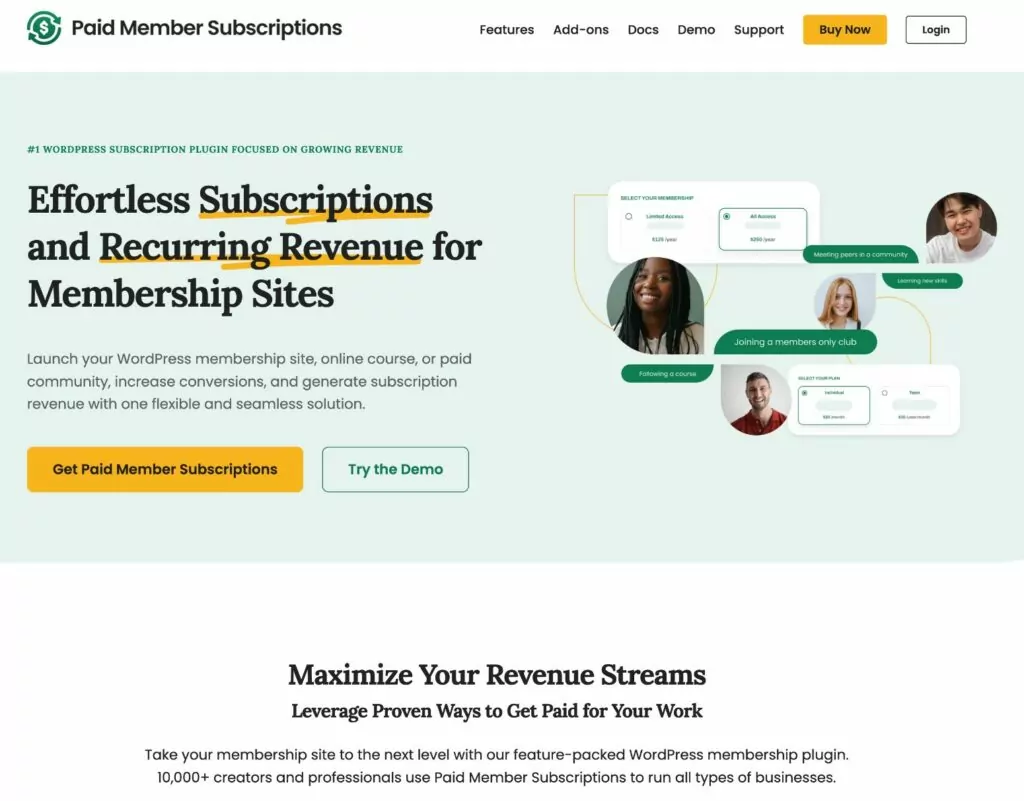
Opt-In Forms + Email Marketing Service
Email nurture campaigns play an essential role in any membership funnel. It’s a lot easier to get a first-time visitor’s email address than it is to get them to pay for a membership plan.
To manage your email subscribers, you’ll need some type of email marketing service. This service will let you create segmented lists for customers at different stages in your funnel and also send them automated email sequences.
To simplify your efforts, you’ll generally want to choose an email marketing service that integrates with your membership website software. For example, if you build your membership website with the Paid Member Subscriptions plugin, you can use the companion Profile Builder plugin to integrate with popular email marketing services like Mailchimp and MailPoet.
To grow your email lists, you’ll also want to create email opt-in forms that are separate from your membership plans. This is important because you might have some people who are willing to subscribe to your email newsletter but not quite ready to become a member.
Lead Magnets
To help you more efficiently grow your list, you’ll usually want to offer some type of lead magnet.
If you’re not familiar with this term, a lead magnet is a free offer that you give as a bonus to people who subscribe to your email list.
For example, you could offer users access to a short ebook or case study in exchange for them subscribing to your list.
Because you offer it for free, the lead magnet is a great way to get your visitors’ emails so that the rest of your membership funnel can do its work to convert them into paying members.
Here’s an example of a lead magnet (access to a recorded webinar) from the Food Blogger Pro membership site.
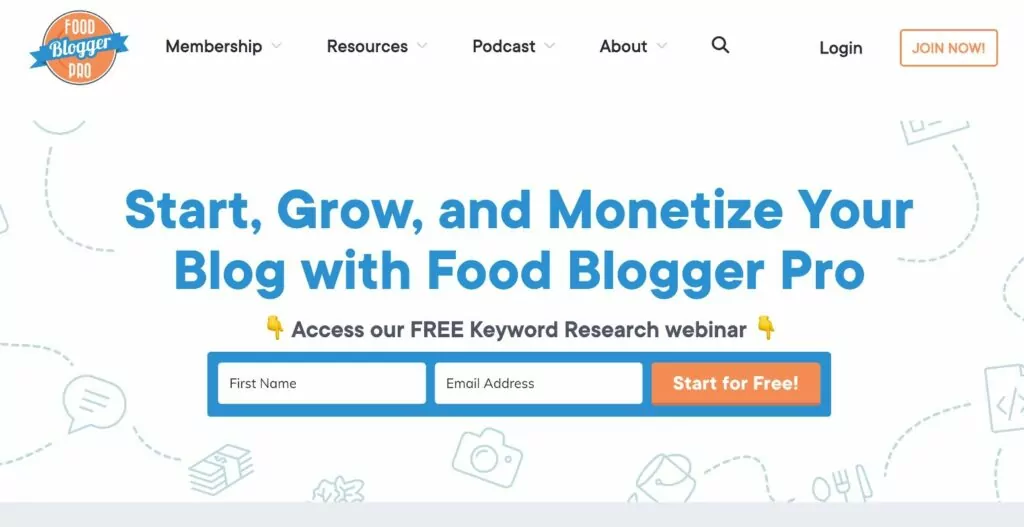
Free Membership Tier (Optional)
There’s a reason the freemium model is so popular with apps and software – it’s a lot easier to convince people to sign up for a free membership than it is to convince them to sign up for a paid membership.
Given that, having a free membership tier can be an important part of your member funnel.
It’s not required – you can build membership funnels with exclusively premium membership plans. But we recommend at least experimenting with a free tier to see if it works for your membership site.
If you use Paid Member Subscriptions, you can easily create a free tier that offers limited access to your site.
For example, Going (formerly Scott’s Cheap Flights) starts users on a free membership tier and then tryies to sell them on a premium membership.
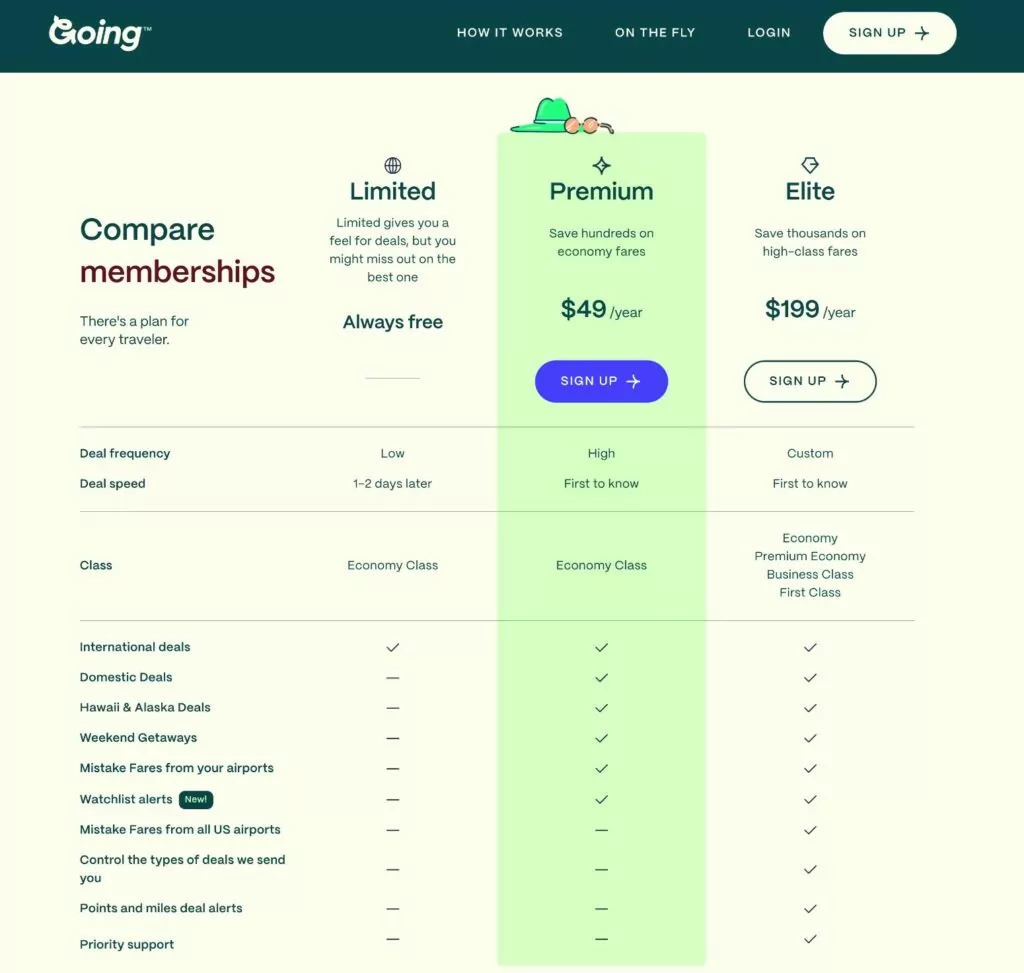
Hierarchical Membership Tiers (Optional)
As we mentioned earlier with respect to Paid Member Subscriptions, setting up hierarchical membership tiers can be a great way to maximize your site’s long-term funnel.
With hierarchical membership tiers, your members can seamlessly upgrade to a higher-tier plan right from their own membership area. This could be moving from a free plan to a paid plan or it could be moving from a cheaper plan to a more expensive plan.
While having hierarchical membership levels is not a requirement to build a membership funnel, it does give you the opportunity to continue nurturing customers even after they make their initial purchases.
If you use Paid Member Subscriptions to make your membership site, you can easily create as many hierarchical membership tiers as needed.
How to Build a Membership Funnel
Now that you understand the key elements of a membership funnel, let’s get into an actual step-by-step guide for how to build your own membership funnel.
1. Identify Your Customer Persona for Your Membership Site
In order to build a successful membership funnel, you need to thoroughly understand the target audience for your membership website.
You probably already have an intuitive understanding of your target customer. However, creating a customer persona will help you clarify things and focus the rest of your member funnel.
Your customer persona should be as specific as possible. For example, instead of saying something like “people who want to get stronger”, get more specific with something like “John, a 35-year-old powerlifter who wants to start competing”.
In some cases, you might have multiple customer personas. That’s ok – just don’t go too far and try to please everyone, as this will make it harder to build an effective member funnel.
For more details, check out HootSuite’s guide on the topic.
2. Generate Leads
Once you have your customer persona in hand, you need to find ways to connect with people who match that persona. In more “marketing’y” terminology, that means you need a way to find leads.
Your goal is to basically find ways to get visitors to a page where you can capture their information. Often, this will just be their email addresses. If you offer a free tier, you also might be able to convert some users directly to free members.
To generate leads, you’ll typically rely on tried-and-true traffic generation strategies such as the following:
- Search engine optimization (SEO) – beyond ranking your membership pages, you can create a blog to use relevant blog posts to connect with people who fit your customer persona. Check out our full guide to SEO for membership websites.
- Social media – you can post and engage on social media to generate organic social traffic to your homepage or blog.
- Paid ads – you can run ads on Google, Facebook, Instagram, TikTok, and other well-known platforms. The exact platforms that you choose will depend on your customer persona.
To capture leads, you’ll want every piece of content on your site to have a call to action (CTA). Typically, this will be your email subscription form.
You could add an inline form in your content or sidebar. Or, you can experiment with popups or other types of placements. You could even experiment with both strategies to find what works best!
To encourage people to part with their email addresses, you can use the free lead magnet that we mentioned earlier. Or, if you have a free tier, you could ask people to sign up for that.
For example, Going has a blog post on “the best time to book a cheap flight” which naturally helps them connect with their target customers. Then, they use a CTA to get those customers onto the free plan.
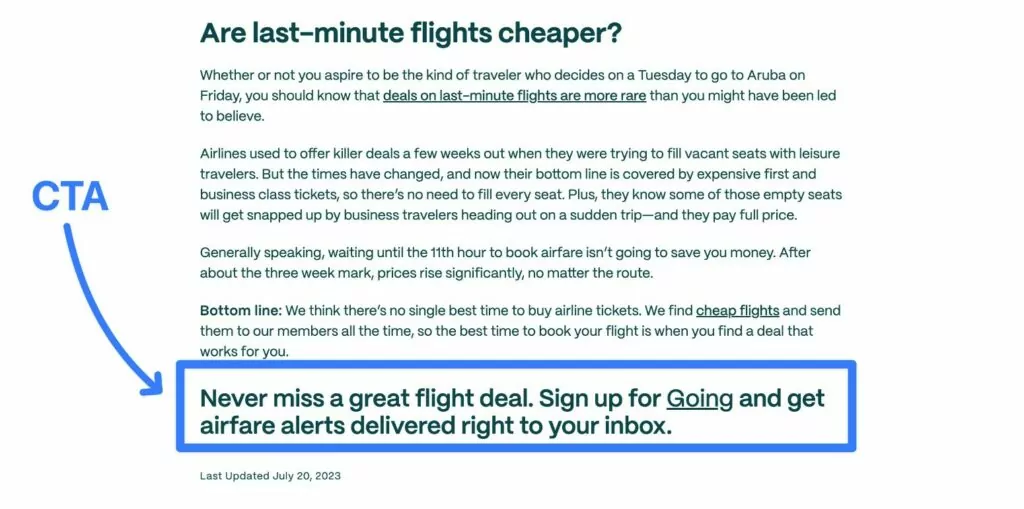
3. Nurture Your Leads
Once you have some leads, your funnel’s next goal is to “nurture” those leads. Essentially, this means finding ways to move a person from first discovering your brand to becoming intimately aware of everything that you offer.
Here are some common strategies to nurture your leads:
- Email campaigns – email campaigns are the foundation of any good sales funnel. You want your email campaigns to naturally increase a customer’s interest in your brand over time. Creating email marketing funnels requires a whole post of its own – here are two great guides from ConvertKit and Omnisend.
- Free tier – offering a free tier for your membership site is a great first step in converting people into paying customers. You could try to move people from your email campaigns to your free tier and then from your free tier to your paid tiers.
- Website content – you want to publish blog posts and website pages for people in different stages of the membership funnel. For example, publishing content that highlights the benefits of your paid tiers is important once you start moving leads through your funnel.
Here’s an example of an email nurture campaign from Food Blogger Pro that’s triggered when someone signs up for the free lead magnet.
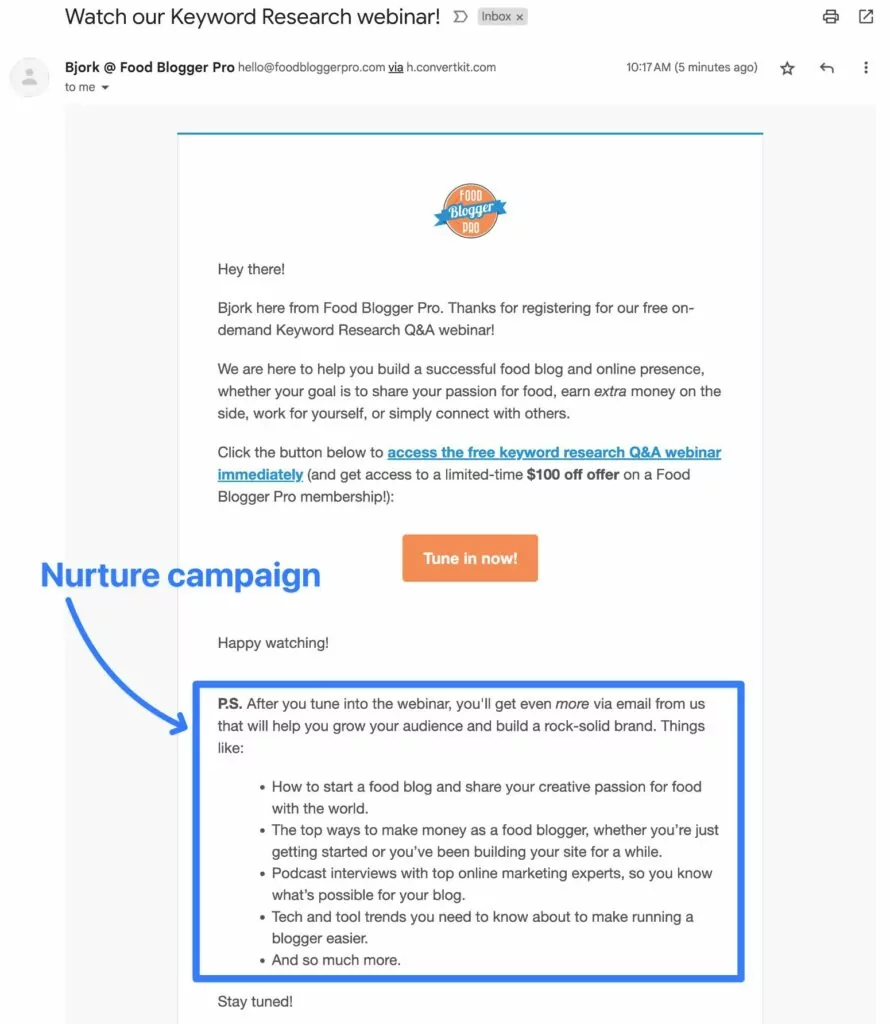
4. Convert Leads Into Members
Once you’ve built a relationship with your audience via your nurturing campaigns, you’re ready to convert them into paying members.
Here are some strategies to help you do that:
- Sales email – once you’ve built up regular engagement in your earlier emails, start selling your subscribers on the benefits of your paid membership plans.
- Sales pages – create dedicated pages on your site that are designed to convert your free email subscribers into paying customers. These pages should be separate from the generic sales pages on your website – you want them to build on the content that you’ve been providing in your email funnel.
- Special offers – offering special deals to email subscribers can be a great way to get them over the hump and turn them into paying subscribers. You can also add urgency with date/time cutoffs to encourage people to act quickly.
For example, back when Going was called Scott’s Cheap Flights, you can see how they sent a sales email that included urgency to get free users to upgrade to a paying membership.
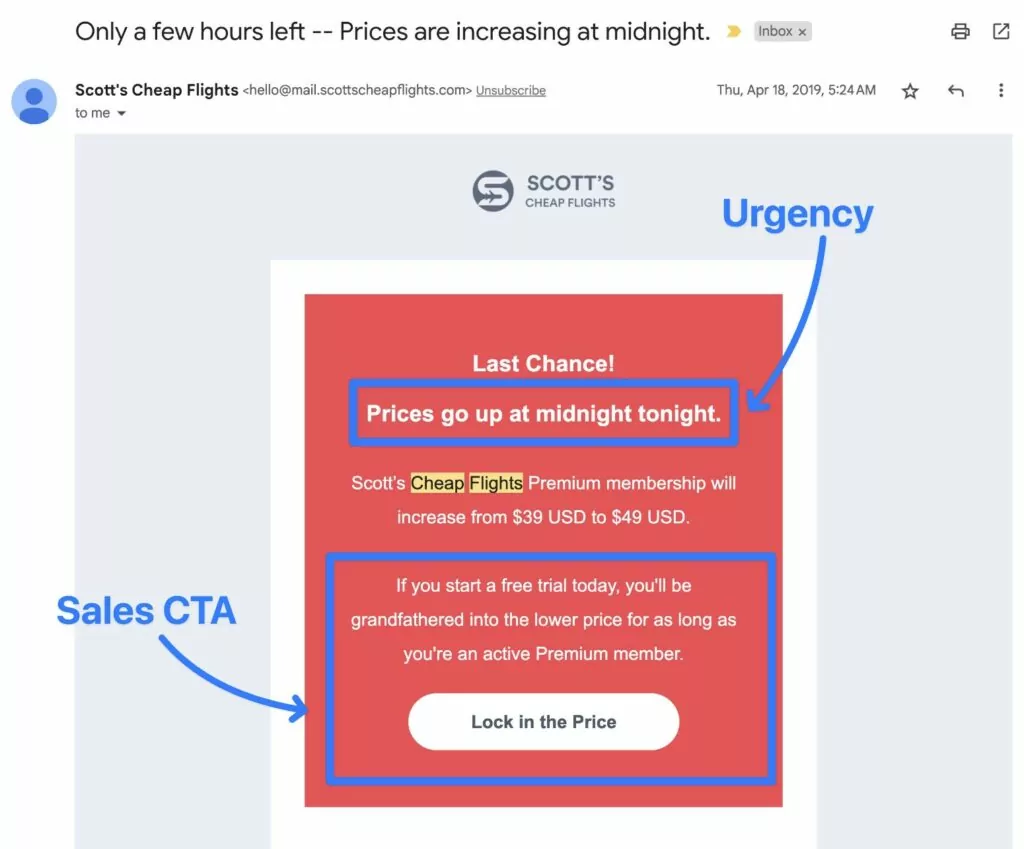
5. Retain and Upgrade Your Members
As we mentioned earlier, one of the key differences between a member funnel vs sales funnel is that your member funnel isn’t finished once you make the initial sale.
You’ll want to continue using your funnel to accomplish two other goals:
- Retain your customers – your membership site will always have some churn, but your membership funnel can reduce as much as possible.
- Upgrade your customers – if you offer multiple hierarchical membership tiers, you’ll also want your funnel to continue moving customers “up” the tiers.
To retain your customers, you can implement strategies such as the following:
- Welcome series – make sure customers know about all of their member benefits by sending them a welcome series that introduces them to important areas of your site.
- Re-engagement emails – if you see that a member hasn’t visited your site in a while, you can send special re-engagement emails to bring them back to your site and reduce the chances that they churn.
- Win-back offers – if a customer does churn, you can send a special win-back offer that gives them the chance to subscribe at a lower rate.
Here’s an example of a successful win-back offer from Man Flow Yoga, a fitness membership site, that offers churned customers a discounted rate to re-join:
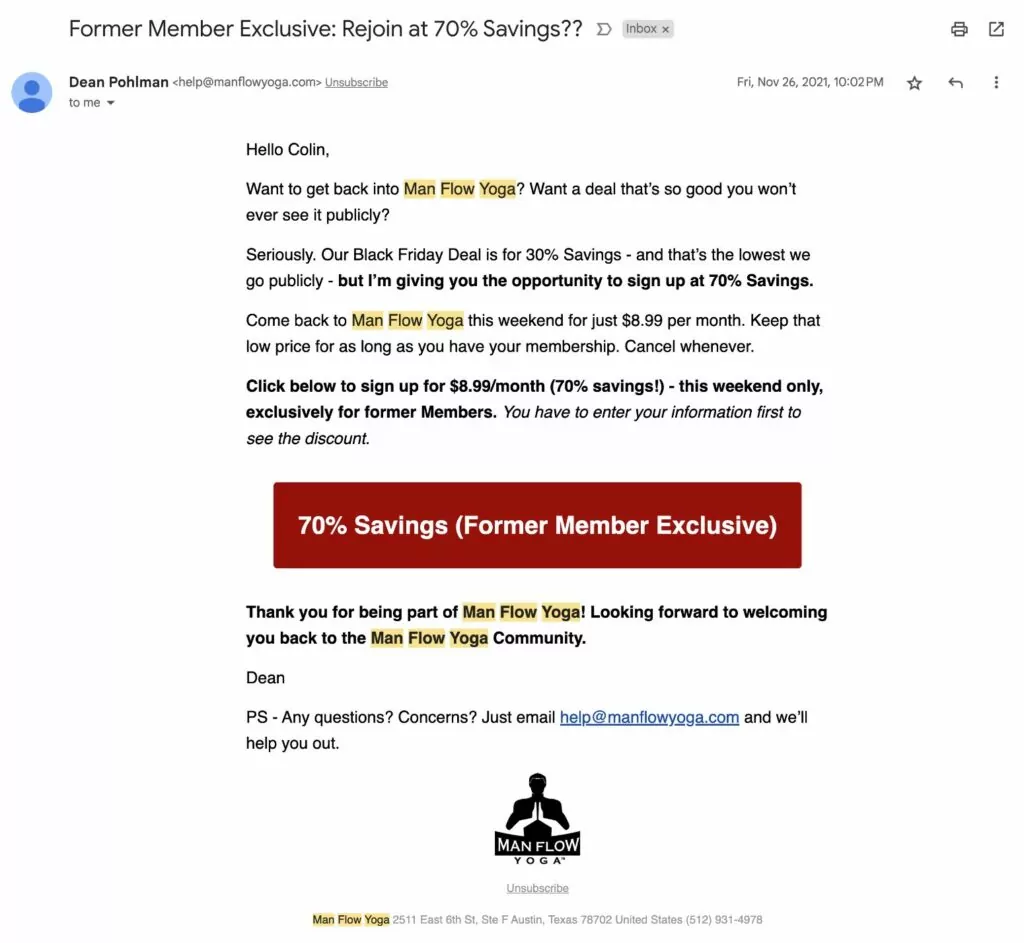
To upgrade your customers, you can consider the following strategies:
- Education – make it easier for people to understand the value of your higher-tier plans by educating them about what’s on offer.
- Discounts and promotions – you can offer special deals if people upgrade their plans. For best results, use limited-time deals and urgency to encourage prompt action.
- Upgrade notices – try to add prominent upgrade CTAs to your site’s account pages and other visible areas.
Get Started With Your First Member Funnel Today
If you want to maximize your membership website’s revenue and build a long-lasting base of customers, creating a membership funnel is important.
With the steps in this article, you can build a member funnel that works for your membership business.
If you want a membership website tool that can help you build successful member funnels, you can use WordPress and the Paid Member Subscriptions plugin to build your membership website.
If you combine Paid Member Subscriptions with an email marketing tool, you have everything that you need to build strong membership funnels and achieve success.
To learn more, go to the Paid Member Subscriptions homepage.
Paid Member Subscriptions Pro
The best tool to build a successful membership website and implement effective member funnels.
Get Paid Member SubscriptionsRelated Articles
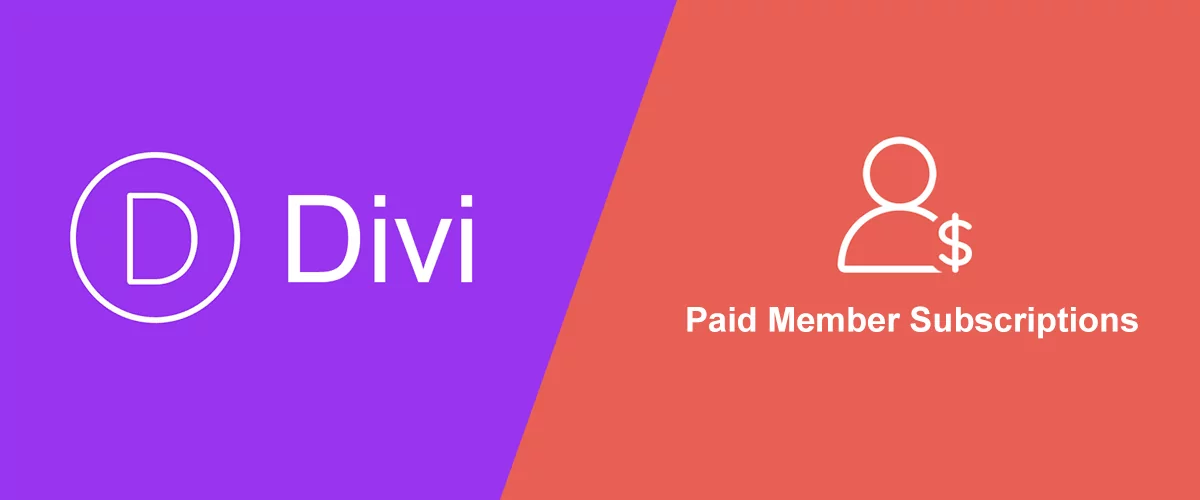
How To Create a Divi Membership Site
If you’re thinking of building a membership site in WordPress, you’ll need a solid theme and a membership plugin that pairs well with it. In this complete guide, we’ll show you how to create a Divi membership site using the popular Divi theme in combination with the Paid Member Subscriptions plugin.
Continue Reading
Membership Blog: Why Start One, Popular Examples and How To
I think you will agree starting a membership blog seems daunting, especially for a first-timer. Talk to just about any beginner who has never created a membership blog (or even a simple website), and they will field questions such as: Why should I start a membership blog? What kind of content, products, or services should […]
Continue Reading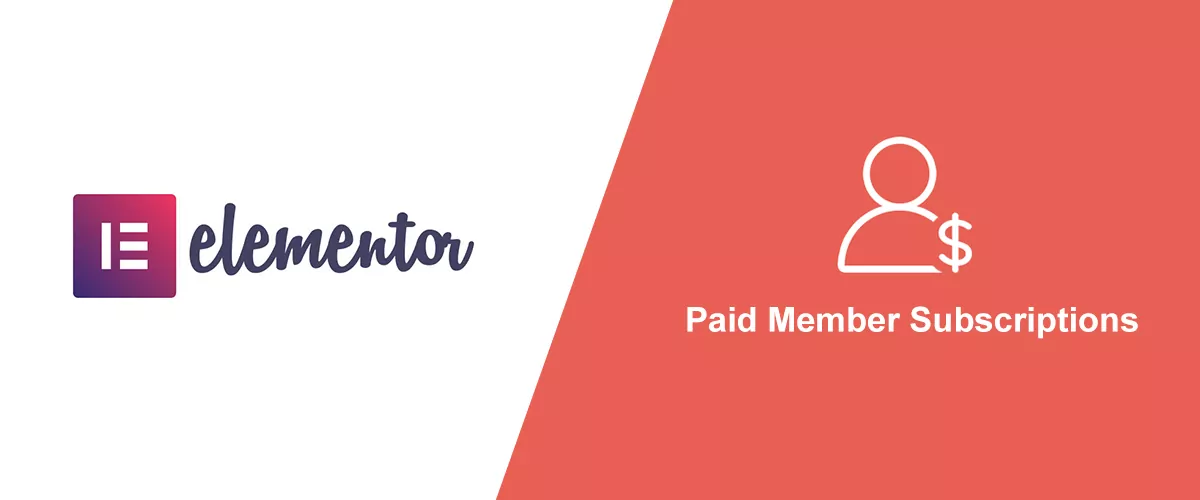
How to Build an Elementor Membership Site with Paid Member Subscriptions
Are you looking to add membership functionality to your Elementor site in WordPress? Perhaps you want to create subscription plans, restrict access to premium content, and accept payments within the popular page builder. The good news is that you can use Paid Member Subscriptions to do all this and more. For example, you can customize restriction […]
Continue Reading

